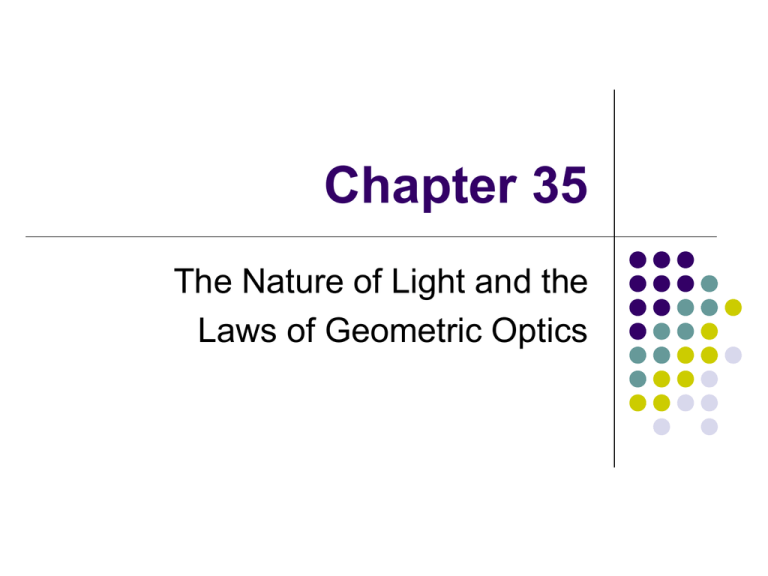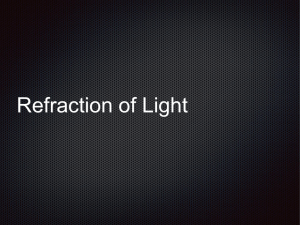chapter35
advertisement

Chapter 35 The Nature of Light and the Laws of Geometric Optics The Nature of Light Before the beginning of the nineteenth century, light was considered to be a stream of particles The particles were either emitted by the object being viewed or emanated from the eyes of the viewer Newton was the chief architect of the particle theory of light He believed the particles left the object and stimulated the sense of sight upon entering the eyes Nature of Light – Alternative View Christian Huygens argued that light might be some sort of a wave motion Thomas Young (in 1801) provided the first clear demonstration of the wave nature of light He showed that light rays interfere with each other Such behavior could not be explained by particles More Confirmation of Wave Nature During the nineteenth century, other developments led to the general acceptance of the wave theory of light Maxwell asserted that light was a form of high-frequency electromagnetic wave Hertz confirmed Maxwell’s predictions Particle Nature Some experiments could not be explained by the wave nature of light The photoelectric effect was a major phenomenon not explained by waves When light strikes a metal surface, electrons are sometimes ejected from the surface The kinetic energy of the ejected electron is independent of the frequency of the light Particle Nature, cont. Einstein (in 1905) proposed an explanation of the photoelectric effect that used the idea of quantization The quantization model assumes that the energy of a light wave is present in particles called photons E = hƒ h is Planck’s Constant and = 6.63 x 10-34 J.s Dual Nature of Light In view of these developments, light must be regarded as having a dual nature Light exhibits the characteristics of a wave in some situations and the characteristics of a particle in other situations Measurements of the Speed of Light Since light travels at a very high speed, early attempts to measure its speed were unsuccessful Remember c = 3.00 x 108 m/s Galileo tried by using two observers separated by about 10 km The reaction time of the observers was more than the transit time of the light Measurement of the Speed of Light – Roemer’s Method Ole Roemer (1675) used astronomical observations to estimate the speed of light He used the period of revolution of Io, a moon of Jupiter, as Jupiter revolved around the sun Roemer’s Method, cont. The periods of revolution were longer when the Earth was receding from Jupiter Shorter when the Earth was approaching Using Roemer’s data, Huygens estimated the lower limit of the speed of light to be 2.3 x 108 m/s This was important because it demonstrated that light has a finite speed as well as giving an estimate of that speed Measurements of the Speed of Light – Fizeau’s Method This was the first successful method for measuring the speed of light by means of a purely terrestrial technique It was developed in 1849 by Armand Fizeau He used a rotating toothed wheel The distance between the wheel (considered to be the source) and a mirror was known Fizeau’s Method, cont. d is the distance between the wheel and the mirror t is the time for one round trip Then c = 2d / t Fizeau found a value of c = 3.1 x 108 m/s The Ray Approximation in Geometric Optics Geometric optics involves the study of the propagation of light It uses the assumption that light travels in a straight-line path in a uniform medium and changes its direction when it meets the surface of a different medium or if the optical properties of the medium are nonuniform The ray approximation is used to represent beams of light Ray Approximation The rays are straight lines perpendicular to the wave fronts With the ray approximation, we assume that a wave moving through a medium travels in a straight line in the direction of its rays Ray Approximation, cont. If a wave meets a barrier, we will assume that λ<<d d is the diameter of the opening This approximation is good for the study of mirrors, lenses, prisms, etc. Other effects occur for openings of other sizes Active Figure 35.4 Adjust the size of the opening Observe the effects on the waves passing through PLAY ACTIVE FIGURE Reflection of Light A ray of light, the incident ray, travels in a medium When it encounters a boundary with a second medium, part of the incident ray is reflected back into the first medium This means it is directed backward into the first medium Specular Reflection Specular reflection is reflection from a smooth surface The reflected rays are parallel to each other All reflection in this text is assumed to be specular Diffuse Reflection Diffuse reflection is reflection from a rough surface The reflected rays travel in a variety of directions A surface behaves as a smooth surface as long as the surface variations are much smaller than the wavelength of the light Law of Reflection The normal is a line perpendicular to the surface It is at the point where the incident ray strikes the surface The incident ray makes an angle of θ1 with the normal The reflected ray makes an angle of θ1’ with the normal Law of Reflection, cont. The angle of reflection is equal to the angle of incidence θ1’= θ1 This relationship is called the Law of Reflection The incident ray, the reflected ray and the normal are all in the same plane Because this situation happens often, an analysis model, wave under reflection, is identified Active Figure 35.6 Use the active figure to vary the angle of incidence Observe the effect on the angle of reflection PLAY ACTIVE FIGURE Multiple Reflections The incident ray strikes the first mirror The reflected ray is directed toward the second mirror There is a second reflection from the second mirror Apply the Law of Reflection and some geometry to determine information about the rays Retroreflection Assume the angle between two mirrors is 90o The reflected beam returns to the source parallel to its original path This phenomenon is called retroreflection Applications include Measuring the distance to the Moon Automobile taillights Traffic signs Refraction of Light When a ray of light traveling through a transparent medium encounters a boundary leading into another transparent medium, part of the energy is reflected and part enters the second medium The ray that enters the second medium is bent at the boundary This bending of the ray is called refraction Refraction, 2 The incident ray, the reflected ray, the refracted ray, and the normal all lie on the same plane The angle of refraction depends upon the material and the angle of incidence sin θ2 v 2 sin θ1 v1 v1 is the speed of the light in the first medium and v2 is its speed in the second Refraction of Light, 3 The path of the light through the refracting surface is reversible For example, a ray that travels from A to B If the ray originated at B, it would follow the line AB to reach point A Following the Reflected and Refracted Rays Ray is the incident ray Ray is the reflected ray Ray is refracted into the lucite Ray is internally reflected in the lucite Ray is refracted as it enters the air from the lucite Active Figure 35.10 Use the active figure to vary the incident angle Observe the effect on the reflected and refracted rays PLAY ACTIVE FIGURE Refraction Details, 1 Light may refract into a material where its speed is lower The angle of refraction is less than the angle of incidence The ray bends toward the normal Refraction Details, 2 Light may refract into a material where its speed is higher The angle of refraction is greater than the angle of incidence The ray bends away from the normal Active Figure 35.11 Use the active figure to observe the light passing through three layers of material Vary the incident angle and the materials Observe the effect on the refracted ray PLAY ACTIVE FIGURE Light in a Medium The light enters from the left The light may encounter an electron The electron may absorb the light, oscillate, and reradiate the light The absorption and radiation cause the average speed of the light moving through the material to decrease The Index of Refraction The speed of light in any material is less than its speed in vacuum The index of refraction, n, of a medium can be defined as speed of light in a vacuum c n speed of light in a medium v Index of Refraction, cont. For a vacuum, n = 1 We assume n = 1 for air also For other media, n > 1 n is a dimensionless number greater than unity n is not necessarily an integer Some Indices of Refraction Frequency Between Media As light travels from one medium to another, its frequency does not change Both the wave speed and the wavelength do change The wavefronts do not pile up, nor are created or destroyed at the boundary, so ƒ must stay the same Index of Refraction Extended The frequency stays the same as the wave travels from one medium to the other v = ƒλ ƒ1 = ƒ2 but v1 v2 so λ1 λ2 The ratio of the indices of refraction of the two media can be expressed as various ratios c λ1 v1 n1 n2 λ2 v 2 c n1 n2 More About Index of Refraction The previous relationship can be simplified to compare wavelengths and indices: λ1n1 = λ2n2 In air, n1 = 1 and the index of refraction of the material can be defined in terms of the wavelengths λ n λn λ in vacuum λ in a medium Snell’s Law of Refraction n1 sin θ1 = n2 sin θ2 θ1 is the angle of incidence θ2 is the angle of refraction The experimental discovery of this relationship is usually credited to Willebrord Snell and is therefore known as Snell’s law of refraction Refraction is a commonplace occurrence, so identify an analysis model as a wave under refraction Snell’s Law – Example Light is refracted into a crown glass slab θ1 = 30.0o, θ2 = ? n1 = 1.00 and n2 = 1.52 From Table 35.1 θ2 = sin-1(n1 / n2) sin θ1 = 19.2o The ray bends toward the normal, as expected Prism A ray of singlewavelength light incident on the prism will emerge at angle d from its original direction of travel d is called the angle of deviation F is the apex angle Huygens’s Principle Huygens assumed that light is a form of wave motion rather than a stream of particles Huygens’s Principle is a geometric construction for determining the position of a new wave at some point based on the knowledge of the wave front that preceded it Huygens’s Principle, cont. All points on a given wave front are taken as point sources for the production of spherical secondary waves, called wavelets, which propagate outward through a medium with speeds characteristic of waves in that medium After some time has passed, the new position of the wave front is the surface tangent to the wavelets Huygens’s Construction for a Plane Wave At t = 0, the wave front is indicated by the plane AA’ The points are representative sources for the wavelets After the wavelets have moved a distance cΔt, a new plane BB’ can be drawn tangent to the wavefronts Huygens’s Construction for a Spherical Wave The inner arc represents part of the spherical wave The points are representative points where wavelets are propagated The new wavefront is tangent at each point to the wavelet Huygens’s Principle and the Law of Reflection The law of reflection can be derived from Huygens’s principle AB is a plane wave front of incident light The wave at A sends out a wavelet centered on A toward D The wave at B sends out a wavelet centered on B toward C AD = BC = cΔt Huygens’s Principle and the Law of Reflection, cont. Triangle ABC is congruent to triangle ADC cos g = BC / AC cos g’ = AD / AC Therefore, cos g = cos g’ and g g’ This gives θ1 = θ1’ This is the law of reflection Huygens’s Principle and the Law of Refraction Ray 1 strikes the surface and at a time interval Δt later, ray 2 strikes the surface During this time interval, the wave at A sends out a wavelet, centered at A, toward D Huygens’s Principle and the Law of Refraction, cont. The wave at B sends out a wavelet, centered at B, toward C The two wavelets travel in different media, therefore their radii are different From triangles ABC and ADC, we find BC v1t sin θ1 AC AC AD v 2 t and sin θ2 AC AC Huygens’s Principle and the Law of Refraction, final The preceding equation can be simplified to sin θ1 v1 sin θ2 v 2 sin θ1 c n1 n2 But sin θ2 c n2 n1 and so n1 sin θ1 n2 sin θ2 This is Snell’s law of refraction Dispersion For a given material, the index of refraction varies with the wavelength of the light passing through the material This dependence of n on λ is called dispersion Snell’s law indicates light of different wavelengths is bent at different angles when incident on a refracting material Variation of Index of Refraction with Wavelength The index of refraction for a material generally decreases with increasing wavelength Violet light bends more than red light when passing into a refracting material Refraction in a Prism Since all the colors have different angles of deviation, white light will spread out into a spectrum Violet deviates the most Red deviates the least The remaining colors are in between The Rainbow A ray of light strikes a drop of water in the atmosphere It undergoes both reflection and refraction First refraction at the front of the drop Violet light will deviate the most Red light will deviate the least The Rainbow, 2 At the back surface the light is reflected It is refracted again as it returns to the front surface and moves into the air The rays leave the drop at various angles The angle between the white light and the most intense violet ray is 40° The angle between the white light and the most intense red ray is 42° Active Figure 35.23 Use the active figure to vary the point at which the sunlight enters the raindrop Observe the angles and verify the maximum angles PLAY ACTIVE FIGURE Observing the Rainbow If a raindrop high in the sky is observed, the red ray is seen A drop lower in the sky would direct violet light to the observer The other colors of the spectra lie in between the red and the violet Double Rainbow The secondary rainbow is fainter than the primary The colors are reversed The secondary rainbow arises from light that makes two reflections from the interior surface before exiting the raindrop Higher-order rainbows are possible, but their intensity is low Total Internal Reflection A phenomenon called total internal reflection can occur when light is directed from a medium having a given index of refraction toward one having a lower index of refraction Possible Beam Directions Possible directions of the beam are indicated by rays numbered 1 through 5 The refracted rays are bent away from the normal since n1 > n2 Critical Angle There is a particular angle of incidence that will result in an angle of refraction of 90° This angle of incidence is called the critical angle, θC n2 sin θC (for n1 n2 ) n1 Active Figure 35.25 Use the active figure to vary the incident angle Observe the effect on the refracted ray PLAY ACTIVE FIGURE Critical Angle, cont. For angles of incidence greater than the critical angle, the beam is entirely reflected at the boundary This ray obeys the law of reflection at the boundary Total internal reflection occurs only when light is directed from a medium of a given index of refraction toward a medium of lower index of refraction Fiber Optics An application of internal reflection Plastic or glass rods are used to “pipe” light from one place to another Applications include Medical examination of internal organs Telecommunications Fiber Optics, cont. A flexible light pipe is called an optical fiber A bundle of parallel fibers (shown) can be used to construct an optical transmission line Construction of an Optical Fiber The transparent core is surrounded by cladding The cladding has a lower n than the core This allows the light in the core to experience total internal reflection The combination is surrounded by the jacket









